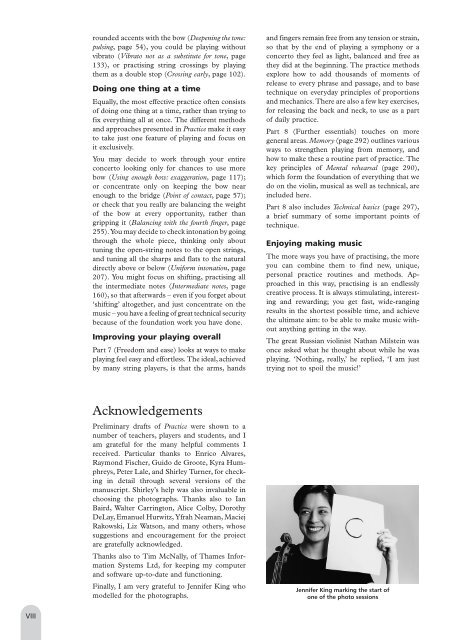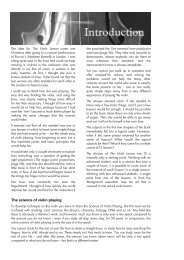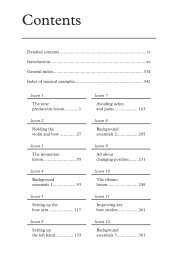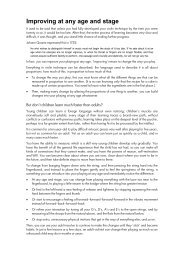here - Simon Fischer
here - Simon Fischer
here - Simon Fischer
You also want an ePaper? Increase the reach of your titles
YUMPU automatically turns print PDFs into web optimized ePapers that Google loves.
ounded accents with the bow (Deepening the tone:<br />
pulsing, page 54), you could be playing without<br />
vibrato (Vibrato not as a substitute for tone, page<br />
133), or practising string crossings by playing<br />
them as a double stop (Crossing early, page 102).<br />
Doing one thing at a time<br />
Equally, the most effective practice often consists<br />
of doing one thing at a time, rather than trying to<br />
fix everything all at once. The different methods<br />
and approaches presented in Practice make it easy<br />
to take just one feature of playing and focus on<br />
it exclusively.<br />
You may decide to work through your entire<br />
concerto looking only for chances to use more<br />
bow (Using enough bow: exaggeration, page 117);<br />
or concentrate only on keeping the bow near<br />
enough to the bridge (Point of contact, page 57);<br />
or check that you really are balancing the weight<br />
of the bow at every opportunity, rather than<br />
gripping it (Balancing with the fourth finger, page<br />
255).You may decide to check intonation by going<br />
through the whole piece, thinking only about<br />
tuning the open-string notes to the open strings,<br />
and tuning all the sharps and flats to the natural<br />
directly above or below (Uniform intonation, page<br />
207). You might focus on shifting, practising all<br />
the intermediate notes (Intermediate notes, page<br />
160), so that afterwards – even if you forget about<br />
‘shifting’ altogether, and just concentrate on the<br />
music – you have a feeling of great technical security<br />
because of the foundation work you have done.<br />
Improving your playing overall<br />
Part 7 (Freedom and ease) looks at ways to make<br />
playing feel easy and effortless. The ideal, achieved<br />
by many string players, is that the arms, hands<br />
and fingers remain free from any tension or strain,<br />
so that by the end of playing a symphony or a<br />
concerto they feel as light, balanced and free as<br />
they did at the beginning. The practice methods<br />
explore how to add thousands of moments of<br />
release to every phrase and passage, and to base<br />
technique on everyday principles of proportions<br />
and mechanics. T<strong>here</strong> are also a few key exercises,<br />
for releasing the back and neck, to use as a part<br />
of daily practice.<br />
Part 8 (Further essentials) touches on more<br />
general areas. Memory (page 292) outlines various<br />
ways to strengthen playing from memory, and<br />
how to make these a routine part of practice. The<br />
key principles of Mental rehearsal (page 290),<br />
which form the foundation of everything that we<br />
do on the violin, musical as well as technical, are<br />
included <strong>here</strong>.<br />
Part 8 also includes Technical basics (page 297),<br />
a brief summary of some important points of<br />
technique.<br />
Enjoying making music<br />
The more ways you have of practising, the more<br />
you can combine them to find new, unique,<br />
personal practice routines and methods. Approached<br />
in this way, practising is an endlessly<br />
creative process. It is always stimulating, interesting<br />
and rewarding; you get fast, wide-ranging<br />
results in the shortest possible time, and achieve<br />
the ultimate aim: to be able to make music without<br />
anything getting in the way.<br />
The great Russian violinist Nathan Milstein was<br />
once asked what he thought about while he was<br />
playing. ‘Nothing, really,’ he replied, ‘I am just<br />
trying not to spoil the music!’<br />
Acknowledgements<br />
Preliminary drafts of Practice were shown to a<br />
number of teachers, players and students, and I<br />
am grateful for the many helpful comments I<br />
received. Particular thanks to Enrico Alvares,<br />
Raymond <strong>Fischer</strong>, Guido de Groote, Kyra Humphreys,<br />
Peter Lale, and Shirley Turner, for checking<br />
in detail through several versions of the<br />
manuscript. Shirley’s help was also invaluable in<br />
choosing the photographs. Thanks also to Ian<br />
Baird, Walter Carrington, Alice Colby, Dorothy<br />
DeLay, Emanuel Hurwitz, Yfrah Neaman, Maciej<br />
Rakowski, Liz Watson, and many others, whose<br />
suggestions and encouragement for the project<br />
are gratefully acknowledged.<br />
Thanks also to Tim McNally, of Thames Information<br />
Systems Ltd, for keeping my computer<br />
and software up-to-date and functioning.<br />
Finally, I am very grateful to Jennifer King who<br />
modelled for the photographs.<br />
Jennifer King marking the start of<br />
one of the photo sessions<br />
VIII






